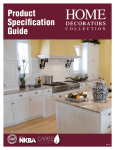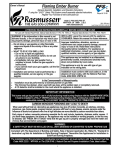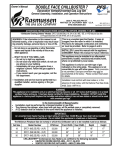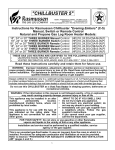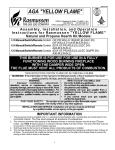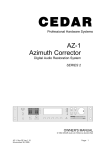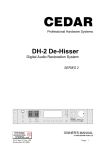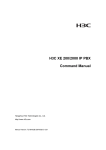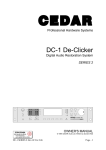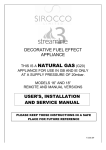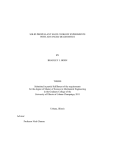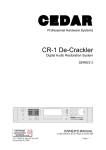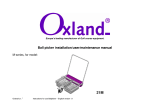Download Rasmussen Yellow Flame Owner`s manual
Transcript
Owner’s Manual YELLOW FLAME DECORATIVE VENTED GAS LOG SET General Assembly, Installation, and Operation Instructions Report #10-40 ® 12028 E. PHILADELPHIA ST. WHITTIER, CA CALIFORNIA 90601 U.S.A. www.rasmussen.biz REV YFZ 0410 Last Printed. 4/28/2010 9:04 AM ATTENTION! READ INSTRUCTIONS CAREFULLY BEFORE ASSEMBLY OR USE Models: “Yellow Flame”; B18, 20, 24 or 30; FH or FXH; -Z 18, 20, 24 or 30; ME, SE, or RE; Natural Gas or Propane Available log set styles and sizes 18” Models: Bonfire, Evening Prestige, LoneStar, Manzanita, Prestige, Frosted Oak, White Birch and CrossFire. 20” Models: Evening CampFire, Evening Desire, Evening LoneStar, Evening Prestige, Evening CrossFire, LoneStar and Frosted Oak. 24” and 30” Models: Bonfire, Evening CampFire, Evening Desire, Evening LoneStar, Evening Prestige, Evening CrossFire, LoneStar, Manzanita, Prestige, Frosted Oak, White Birch and CrossFire. INSTALLER: Leave this manual with the appliance. CONSUMER: Retain this manual for future reference. WARNING: If the information in this manual is not followed exactly, a fire or explosion may result causing property damage, personal injury or loss of life. — Do not store or use gasoline or other flammable vapors and liquids in the vicinity of this or any other appliance. — WHAT TO DO IF YOU SMELL GAS • Do not try to light any appliance. • Do not touch any electrical switch; do not use any phone in your building. • Immediately call your gas supplier from a neighbor’s phone. Follow the gas supplier’s instructions. • If you cannot reach your gas supplier, call the fire department. — Installation and service must be performed by a qualified installer, service agency or the gas supplier. • • • Improper installation, alteration, service or maintenance can cause property damage, personal injury or loss of life. Read these instructions thoroughly before installation. For assistance or additional information, consult your gas log dealer, qualified installer, service agency or gas supplier. This appliance may be installed in an aftermarket, permanently located, manufactured (mobile) home, where not prohibited by local codes. This appliance is only for use with type of gas indicated on the rating plate. Installation must conform with local codes or, in the absence of local codes, with the National Fuel Gas Code, ANSI Z223.1/NFPA 54. In the Commonwealth of Massachusetts: Installation must be performed by a licensed plumber or gas fitter. The chimney flue damper, when used with gas logs, will be welded open or completely removed. A CO detector shall be installed in the room where the appliance is installed. WARNING This is a vented gas appliance for use only in a solid-fuel burning fireplace constructed on non-combustible material with a fully functional chimney flue which must vent all of the products of combustion. WHEN OPERATING, THE CHIMNEY DAMPER MUST BE FULLY OPEN MINIMUM FIREPLACE FLUE REQUIREMENTS The minimum permanent chimney or damper opening is the minimum permanent free opening required by Standards or Codes to ensure safe operation of the appliance and must be at least 39 square inches for 18”-20” models, 51 square inches on 24” models and 64” on 30” models based on a minimum chimney height of 10 feet. It is NOT the minimum operating damper position, which should be wide open when burning. Yellow Flame Contemporary Gas Heaters are certified to the following standards: VENTED DECORATIVE APPLIANCE - ANSI Z21.60b-2004, CSA 2.26b-2004 1 • • • • • • • • • • • • • • • • • • • IMPORTANT INFORMATION Due to high temperatures, the appliance should be located out of traffic and away from furniture and draperies. Children and adults should be alerted to the hazard of high surface temperatures and should stay away to avoid burns or clothing ignition. Young children should be carefully supervised when they are in the same room with the appliance. Do not place clothing or other flammable material on or near the appliance. Any safety screen or guard removed for servicing an appliance must be replaced prior to operating the appliance. Installation and repair should be done by a qualified service person. The appliance should be inspected before use and at least annually by a professional service person. More frequent cleaning may be required due to excessive lint from carpeting, bedding material etc. It is imperative that control compartments, burners and circulating air passageways of the appliance be kept clean. WARNING: Any change to this appliance or its controls can be dangerous. WARNING: Failure to keep the primary air opening(s) of the burner clean may result in sooting and property damage. Keep appliance area clear and free from combustible materials, gasoline and other flammable vapors and liquids. DO NOT use this room appliance if any part has been under water. Immediately call a qualified service technician to inspect the appliance and to replace any part of the control system and any gas control that has been under water. WARNING: Before installing in a solid-fuel burning fireplace, the chimney flue and firebox must be cleaned of soot, creosote, ashes and loose paint by a qualified chimney cleaner. WARNING: Do not allow fans to blow directly into the fireplace. Avoid any drafts that alter burner flame patterns. WARNING: Do not use a blower insert, heat exchanger insert or any other accessory not approved for use with this heater. A fireplace screen must be in place when the appliance is operating and, unless other provisions for combustion air are provided, the screen shall have an opening(s) for introduction of combustion air. Solid fuels shall not be burned in a fireplace where this appliance is installed. WARNING: Glass doors must be fully opened when appliance is in operation to allow for safe combustion, cooling of components and venting. Any outside air ducts and/or ash dumps in the fireplace shall be permanently closed at the time of appliance installation. This appliance may be used in sleeping quarters and bathrooms if used in a vented application, subject to local codes. Avoid contact with the objects, chassis or another part which may be hot during operation. Your gas log is assembled at the factory to be installed in a fireplace plumbed with the gas supply on the right side (facing unit). DO NOT convert to the left side of burner. Instead, run connecting pipe or aluminum flex connector (per local codes) behind burner along the back wall of fireplace bringing your gas line to the right side. CARBON MONOXIDE POISONING MAY LEAD TO DEATH When used without fresh air, decorative gas appliances may give off carbon monoxide, an odorless, colorless, poisonous gas. Some people, pregnant women, persons with heart or lung disease, anemia, persons under the influence of alcohol and persons who live at high altitudes are more affected by carbon monoxide than others. Early signs of carbon monoxide poisoning resemble the flu and include; headache, dizziness and/or nausea. If you have these symptoms, the burner or the appliance may not be installed or working properly, or the flue may be blocked. GET FRESH AIR AT ONCE! Verify that the gas log set is properly arranged and have the heater and chimney flue serviced before using again. WARNING During manufacturing, assembly and packaging, various components of this appliance are exposed to certain oils or films. These are not harmful but may produce annoying smoke and smells as they are burned off during the initial operation of the appliance, possibly causing headaches, eye or lung irritation. This is a normal occurrance and only temporary. The initial break-in operation should last 2-3 hours with the burner at the highest setting. Provide maximum ventilation by opening windows, doors and the chimney flue (if using a vented model) to allow odors to dissipate. The only odor remaining after this initial break-in period will be the normal odors associated with the combustion of Natural or Propane Gas and/or related to your indoor environment (see page 12). WARNING—Proposition 65 Statement If not installed, operated and maintained in accordance with these instructions, this product could expose you to substances in fuel or from fuel combustion which are known to the State of California to cause cancer, birth defects or other reproductive harm. 2 PARTS LIST REQUIRED TOOLS AND MATERIALS Adjustable Wrench and Pipe Wrench. Pipe Sealing compound is required if fittings not already pre-threaded with Teflon tape to prevent gas leaks. DO NOT use Teflon tape or pipe compound on other tapered fittings. 1. 2. 3. 4. 5. 6. 7. 8. 9a. 9b. 10. 11. Rating/I.D. Plate (Chained to Burner assembly) Grate (HFG18, 20, 24, and 30) Burner Pan (F or FX18, 20, 24, and 30) Orifice Size Chart Burner Plug (445686-U) 3/8” x 1/2” FIP Flared Brass Fitting (A1) Orifice Spud (see chart for size) Orifice Holder (Internally Tapped 3/8” x 3/8” Flared MIP Fitting) (A2T) Air Mixer for Propane Gas burners (MA2) Reducing Coupling (Natural Gas) Damper Clamp (DC1) Log Lifters (LL) 18 Hand held variable remote for “-RE” models 12. Valve Knob Extender for Manual (STR-RMD) “EASY” Safety Valve (STV-KE2) 19. White Silica Sand (Natural Gas burners) 13a. Thermocouple for Propane (J95R/P) 13b. Thermocouple for Natural Gas (J95R/N) 20. Ember Magic (EMX1) 21. Black Volcanic Ash (Propane burners) 14. Pilot Bracket (PB1) 22. Wireless Remote Transmitter Devices For 15. Flex Connector (SSCB-14) “-SE” Models (each sold separately) 16. Grate Attaching Bracket A Wireless On/Off Remote (SR-2R) 17A Manual “EASY” Safety Valve (-ME) B Wireless On/Off Remote with Thermostat (STV-10) with R-1 Regulator (THR-2R) 17B Remote Ready “EASY” Safety Valve C Wireless Wall Thermostat (TS-2R) (-SE) (STV-LS) with R-1 Regulator D Wireless Wall Switch (WS-2R) 17C Variable Flame Height “EASY” Safety E Wireless Wall Timer (30/60/120 Minutes) Valve (-RE) (STR-VMD) (WT-2R) with R-1 Regulator 23. Receiver for “-SE” or “-RE” (BPR3) 2 Grate Attaching Bracket Flex Connector Input Valve “EASY” Safety Valve Burner Plug 1 4 Log Size 18" 20"/21" 24" 30" 3 Burner Pipe 6 5 14b Ember Burners 9a 13 11 9b 12 10 15 18 17 A. 14a Orifice Size -N -P #34 #51 #33 #50 #18 #43 #11 #41 Pilot Thermocouple Assembly 8 7 Burner Size B18FH or FXH B20FH or FXH B24FH or FXH B30FH or FXH C. B. 16 22 20 A. 21 B. C. D. 19 23 3 E. GENERAL INSTALLATION INSTRUCTIONS WARNING: Failure to position the parts in accordance with these diagrams or failure to use only parts specifically approved with this appliance may result in property damage or personal injury. The appliance and it’s appliance main gas valve must be disconnected from the gas supply piping system during any pressure testing of that system at test pressures in excess of 1/2 psi. The appliance must be isolated from the gas piping system by closing its equipment shutoff valve during any pressure testing of the gas supply piping system at test pressures equal to or less than 1/2 psi. Natural Gas Operating Pressures: Minimum inlet gas supply pressure = 6 inches of water column. Maximum inlet gas supply pressure is 7 inches of water column. Propane Gas Operating Pressures: Minimum inlet gas supply pressure = 11 inches of water column. The maximum inlet gas supply pressure is 14 inches of water column. STEP ONE PREPARATION: 1. Verify that the Valve Assembly is correctly matched to the log set, burner, and gas supply. 2. Turn off Fireplace Gas Supply (Figure 1A) . 3. Thoroughly clean fireplace floor of any ashes and have a qualified chimney cleaner insure that the chimney flue and firebox are free of soot, creosote, and loose paint. 4. Attach Damper Clamp (Figure 2A) over edge of fireplace Damper Blade (Figure 2B) to prevent damper from fully closing accidentally. If unable to attach damper clamp, drill a hole (or holes) in the damper or remove it completely. FIGURE 1 Log Lighter Valve Assembly (V1) A) Fireplace Gas Supply Valve Opening Height (16” Minimum) Flue A) Damper Clamp B) Damper Blade FIGURE 2 Gas Supply Pipe • • • In the Commonwealth of Massachusetts: Installation must be performed by a licensed plumber or gas fitter. The chimney flue damper, when used with gas logs, will be welded open or completely removed. A CO detector shall be installed in the room where the appliance is installed. IMPORTANT: THE CHIMNEY DAMPER MUST BE WIDE OPEN AND FIXED IN A MANNER TO MAINTAIN A PERMANENT FREE OPENING AT ALL TIMES AS OUTLINED ABOVE. THE AREA OF THE FLUE MUST BE NOT LESS THAN 1/10 THE AREA OF THE FIREPLACE OPENING. THIS GAS LOG SET MUST BE INSTALLED IN A FULLY VENTED METAL OR MASONRY FIREPLACE WITH A WORKING FLUE THAT IS SAFE FOR BURNING A WOOD FIRE. THE FLUE MUST BE FREE OF ANY OBSTRUCTIONS AND MUST EXHAUST ALL PRODUCTS OF COMBUSTION. DAMPER AND GLASS DOORS MUST BE FULLY OPEN BEFORE LIGHTING OR BURNING FOR PROPER VENTILATION AND TO PREVENT HEAT DAMAGE TO THE VALVE. WARNING! CHECK FOR PROPER VENTING A properly sized, unobstructed chimney will normally vent all products of combustion. Any odor or smoke detected inside the room is an indication that the flue is not functioning properly. SHUT OFF THE BURNER IMMEDIATELY! THE CAUSE OF THE VENTING PROBLEM MUST BE DISCOVERED AND CORRECTED BEFORE CONTINUED USE OF THE GAS LOG SET. Continued use with improper venting may cause damage to your fireplace, room furnishings and could cause serious illness. IF IMPROPER VENTING IS SUSPECTED, IMMEDIATELY HAVE LOG SET AND CHIMNEY FLUE SERVICED. The installation and the provisions for combustion and ventilation air must conform with The National Fuel Gas Code ANSI Z223.1 / NFPA54, or The CSA B149.1, Natural Gas and Propane Installation Code, latest edition. 4 INSTALLATION AND GAS SUPPLY CONNECTION STEP TWO: BURNER INSTALLATION 1. Place Burner-Grate Assembly inside the firebox, centered from left to right, within 1” to 2” of rear wall (Figure 4). 2. The “EASY” Safety Valve should be placed as far forward and to the side of the burner pan as possible (Figure 4B). It may also be placed Open face side down (Figure 3, right) STEP THREE: GAS SUPPLY CONNECTION (For Gas Type Conversion see Page 11) 1. Insure that the Gas Supply to the Fireplace is turned off. Verify correct gas type and proper gas pressures. 2. Thread 1/2” FIP x 3/8” Flared Elbow (Figures 3 and 4C) onto the Gas Supply Pipe (B) and wrench tighten. 3. Thread one end of the supplied Flex Connector (Figures 3 and 4E) to the Valve Input (Figure 5), then connect the other end to the 1/2” FIP x 3/8” Flared Elbow attached to the Gas Supply Pipe. If Flex Connector is bent into too small a radius it may kink or break causing air flow noise and/or gas leaks. Rear Width (Not less than log set size) A) 1 to 2” from rear wall D) Gas Supply Pipe E) Flex Connector C) 1/2” FIP x 3/8” Flared Elbow FIGURE 3 Valve Input FIGURE 5 E) Flex Connector Connected from 1/2” FIP x 3/8” Elbow to Valve Input FIGURE 4 D) Gas Supply Pipe Minimum Depth 12” Burner Pipe C) 1/2” FIP x 3/8” Flared Elbow B) “EASY” Safety Valve Front Width (Minimum 6” greater than log set size) Long Valve Key (K2) MINIMUM FIREPLACE REQUIREMENTS The Minimum permanent chimney or damper opening is the minimum permanent free opening required by Standards or Codes to ensure safe operation of the appliance and must be at least 39 square inches for 18”-20” models, 51 square inches on 24” models and 64” on 30” models based on a minimum chimney height of 10 feet. It is NOT the minimum operating damper position. Rear Chimney Min. Permanent Btu./Hour - Max. Input Model Log Set Opening Firebox Front Natural Propane Chimney Number Height Depth Firebox Firebox Diameter Size Width Gas Gas Width Opening B18FH-Z18 B18FXH-Z18 B20FH-Z20 B20FXH-Z20 B24FH-Z24 B24FXH-Z24 B30FH-Z30 B30FXH-Z30 18" 18" 20"/21" 20"/21" 24" 24" 30"/36" 30"/36" 16" 16" 16" 16" 16" 16" 16" 16" 12" 14" 12" 14" 12" 14" 12" 14" 26" 26" 28" 28" 32" 32" 38" 38" 20" 20" 22" 22" 26" 26" 32" 32" 5 7” 7” 7” 7” 7” 7” 8” 8” 39 SQ" 39 SQ" 39 SQ" 39 SQ" 51 SQ" 51 SQ" 64 SQ" 64 SQ" 37,000 37,000 42,000 42,000 70,000 70,000 80,000 80,000 33,000 33,000 35,000 35,000 55,000 55,000 60,000 60,000 PAN MEDIUM (Amount supplied will vary with each size and style of burner) STEP ONE: Completely cover Burner Pipe and Ember Boosters with Pan Medium (Figures 6 and 7A) starting from rear of burner pan and moving toward leading edge. Use entire contents of bag provided, allowing medium to spill over leading edge of burner pan Figures 6 and 7B. If using a Natural Gas burner (e.g. FX model), the Pan Medium used will be White Sand as shown in Figure 6. If using a Propane Gas burner (e.g. FAX model), the Pan Medium used will be Volcanic Ash, as shown in Figure 7. If using a Natural Gas model, the Volcanic Ash supplied can be used as dressing for the firebox floor (See page 8). NEVER use White Sand inside a propane gas burner. FIGURE 6 Natural Gas FIGURE 7 Propane A) Ember Boosters A) Ember Boosters Leading Edge Leading Edge STEP TWO: Sprinkle a light covering of “ Ember Magic” over the Pan Medium (Figure 8 A and B). Pull apart “Ember Magic” fiber material to enhance the glowing ember effect. Spread remaining “Ember Magic” around ends of pan to add to the ember bed appearance. When done the Burner pan should look somewhat like the illustration below. (See page 8 also) FIGURE 8 B) Propane A) Natural Gas WARNING: Failure to position the parts in accordance with these diagrams or failure to use only parts specifically approved with this heater may result in property damage or personal injury. WARNING: NEVER use White Sand inside a propane gas burner. 6 LOG PLACEMENT CAUTION: Crowded logs will cause poor combustion and result in excessive soot formation. Depending on the log style and size, log sets contain from 6 to 10 individual logs and sometimes pinecones. The largest logs will be the Front and Rear Logs. Some log sets have two separate front logs which simulate a charred/burnt effect between the two halves. (Figure 12) Place the Longest Log (or 2 largest “charred” logs if applicable) as far forward on the Grate as possible. The next Longest Log is placed as far to the rear as possible on top of optional Log lifters (Figure 9A) (if provided). The remaining logs, or “Top Logs” are placed diagonally across the Front and Rear logs with the larger top logs placed first allowing flame to pass freely between them. Several examples are provided below with Burner Pan and “EASY” Safety Valve omitted for clarity. FIGURE 9 Side View of 18” LoneStar Log Set (LS18) Large Top Log Front Log Small Top Log A) Log Lifters FIGURE 10 Front View of 24” CrossFire Log Set (XF24) Small Top Logs Large Top Log Large Top Log Rear Log Front Log FIGURE 21 Top View of 24” Evening Crossfire log set FIGURE 20 Top View of 18” Lone Star log set Large Top Log Small Top Rear Log Log Small Top Logs Small Top Log Rear Log Large Top Log Large Top Log Front Log A) Two Front Charred Logs Available log set styles and sizes 18” Models; Bonfire, Evening Prestige, LoneStar, Manzanita, Prestige, Frosted Oak, White Birch and CrossFire. 20” Models; Evening CampFire, Evening Desire, Evening LoneStar, Evening Prestige, Evening CrossFire, LoneStar and Frosted Oak. 24” and 30” Models; Bonfire, Evening CampFire, Evening Desire, Evening LoneStar, Evening Prestige, Evening CrossFire, LoneStar,Manzanita, Prestige, Frosted Oak, White Birch and CrossFire. WARNING: Failure to position the parts in accordance with these diagrams or failure to use only parts specifically approved with this heater may result in property damage or personal injury. IMPORTANT! YOUR GAS LOG SET SHOULD BE OPERATED FOR THE FIRST 2-3 HOURS AT A LOW FLAME SETTING TO ALLOW TEMPERING OF THE REFRACTORY LOGS. 7 PLACEMENT OF “EASY” SAFETY VALVE AND REMOTE RECEIVER The “EASY” Safety Valve (Figures 13 and 17A) and Remote Receiver (-RE and -SE models) (Figure 17A) are both adversely affected by heat and must be placed as far forward and to the side of the burner pan as possible. The “EASY” Safety Valve may also be placed open face side down with heat shield up as shown in Figure 14. Our optional Ceramic Log House accessory (item # RH2) (Figure 15), offers heat protection for the Remote Receiver while being pleasing to the eye. When connecting receiver to “EASY” Safety Valve be sure to match red and black connectors, red to red and black to black). Also sold separately, is our “Stand Alone Crackler” which mimics the sound of a crackling fire adding a cozy feel to your log set (Figure 16). FIGURE 13 30” Natural Gas Model shown at right prior to log placement Black Volcanic Ash used for decoration A) “EASY” Safety Valve Embers spread over White Sand FIGURE 14 FIGURE 15 B) FIGURE 16 C) FIGURE 17 30” Propane Model shown at right with LoneStar set and Remote Receiver for “-RE or “-SE” Units. B) Remote Receiver (“-RE” or”-SE” Models) Embers spread over Volcanic Ash 8 A) “EASY” Safety Valve LIGHTING AND OPERATION IMPORTANT! CHIMNEY DAMPER MUST BE WIDE OPEN! THE FLUE MUST VENT ALL PRODUCTS OF COMBUSTION. DAMPER AND GLASS DOORS MUST BE FULLY OPEN BEFORE LIGHTING OR BURNING FOR PROPER VENTILATION AND TO PREVENT HEAT DAMAGE TO VALVE. STEP ONE: PILOT LIGHTING (ALL MODELS) FIGURE 18 C) KNOB POSITION INDICATOR B) PILOT ADJUSTMENT SCREW 1. Turn VALVE KNOB (Figure 18A) to “PILOT” position. 2. Depress and hold until air is bled and gas flows to Pilot (Figure 18A). 3. Light Pilot with a Match or Lighter. 4. Once Pilot is lit, continue to depress and hold until the Pilot flame remains lit (approximately 30 to 60 seconds). 5. If Pilot does not remain lit, depress and turn Valve Knob clockwise to “OFF” position and wait at least 5 minutes to allow gas to dissipate. Repeat steps 1 thru 4. A) VALVE KNOB VALVE PLUG (“ME” MANUAL “EASY” CONTROL) SHOWN ABOVE ALSO, LOCATION FOR; ● ON/OFF SOLENOID (“SE” REMOTE READY MODELS) OR • DC MOTOR DRIVE (“RE” VARIABLE FLAME HEIGHT MODELS) BOTH SHOWN ON FOLLOWING PAGE. FIGURE 19 STEP TWO: PILOT ADJUSTMENT (ALL MODELS) Pilot Thermocouple Assembly A) Pilot 1. The Pilot flame should be steady, surrounding the THERMOCOUPLE TIP (Figure 19B). 2. If pilot flame adjustment is necessary, use a narrow long stem flathead screwdriver to turn PILOT ADJUSTMENT SCREW (Figure 18B) above. 3. Turn clockwise for less flame, counterclockwise for more. B) Thermocouple Tip 4. If after pilot adjustment the burner begins to shutdown, re-adjust for a longer pilot flame. STEP THREE: BURNER OPERATION (“ME” MANUAL “EASY” SAFETY CONTROL MODELS) FIGURE 20 1. Turn VALVE KNOB counter clockwise to “ON” position (Figure 20). 2. Adjust the burner flame height by turning the valve knob clockwise to lower and counter-clockwise to raise up to full on. NOTE: The VALVE KNOB has complete control of gas to the pilot and burner. It cannot be turned to “OFF” without first depressing dial to the “PILOT “ position and then rotating clockwise to “OFF”. During the heating season leave valve knob in “PILOT” position for convenience. Otherwise, turn to “OFF” position for any prolonged non-use. 9 FULL ON LOWER BURNER OPERATION (“RE” VARIABLE FLAME HEIGHT MODELS AND“SE” REMOTE READY MODELS) FIGURE 21 1. Turn VALVE KNOB to “ON” position (Figure 21A) 2. Slide switch on the RECEIVER (Figure 22) to “REMOTE” position. “RE Models KNOB POSITION INDICATOR C) PILOT ADJUSTMENT SCREW B) TRANSMITTER 3. Depress the “ON/HI” button on the TRANSMITTER (Figure 22) until a click is heard. The burner will then light to “Full on” NOTE: Reducing the burner flame can be achieved by pressing the “LO” button one beep at a time to the desired flame height. Pressing the “ON/HI” button one beep at a time will raise the burner flame). To verify the burner is completely off, press the “OFF” button once. DC Variable Motor Drive “SE” Models 3. Consult Operating Instructions for Accessory Control (below). A) VALVE KNOB FIGURE 22 Slide Switch in “REMOTE” Position 4. Adjust the burner flame height by turning the valve knob (Figure 23A) clockwise to lower and counter-clockwise to raise up to full on. NOTE: THE RECEIVER HAS 3 POSITIONS; “OFF”, “FULL ON” AND “REMOTE ACCESS ON” NOTE: During the heating season leave valve knob in “PILOT” position for convenience. Otherwise, turn to “OFF” position for any prolonged non-use. Accessory Controls Wireless On/Off Remote (SR-2R) Wireless On/Off Remote with Thermostat (THR-2R) Wireless Wall Thermostat (TS-2R) Wireless Wireless Wall Wall Timer Switch (WS-2R) (Up to 120 Minutes) (WT-2R) FIGURE 23 KNOB POSITION INDICATOR ON/OFF SOLENOID B) PILOT ADJUSTMENT SCREW A) VALVE KNOB SERVICE AND TROUBLESHOOTING GUIDE FOR THE “EASY” SAFETY PILOT KIT Analysis and correction of control of service problems must be made by qualified gas service technicians only. Attempts to service or repair the “EASY” Safety Pilot Kit by other than authorized service personnel will void the manufacture’s warranty. In general , failure of “EASY” Safety Pilot Control may be due to the reasons noted below: 1. Pilot will not light initially: ● Check for loose Thermocouple terminal nut connection. ● Check for improper pilot flame adjustment. ● Check that Valve Knob is fully depressed during pilot lighting operation and hold for 30 to 60 seconds. ● Check for defective Thermocouple. ● Check for defective thermo magnet unit. 2. Pilot / Main burner clicks off after 5 to 30 minutes of burning: ● Valve and Thermocouple are not defective, otherwise pilot would not initially light. ● Thermocouple loses temperature difference between hot tip and cold junction (base). ● Check that only tip of Thermocouple is in main burner flame. ● Remove then replace logs to alter heat radiation pattern. Ensure that glass doors are open. ● Ensure that proper size gas log set is installed. Too large of a set decreases cooling air flow. 10 NORMAL OPERATING CHARACTERISTICS Each and every Yellow Flame that leaves the factory is quality checked to ensure compliance with our certification. This check includes an operational test to ensure both satisfactory combustion and proper operation. A normally operating Yellow Flame Gas Fire Set possess the following characteristics: A yellow bodied wood-like flame that will produce carbon soot. The carbon soot produced is natural and adds to the realistic appearance of the set. If the carbon becomes excessive, operate the set for ten minutes to heat the logs, then spray the sooty area with water. This dislodges the soot , which is carried up the chimney by the natural draft. • The pilot flame should be blue in appearance. • CUSTOMER RESPONSIBILITIES AND PERIODIC MAINTENANCE • • • • • • • • • • • • Keep the area around the Yellow Flame free and clear from debris. From time to time, visually check pilot and burner flames for proper appearance. The pilot burner should be free of lint and dirt. Use a brush with stiff bristles to clean the pilot. The main burner should produce a relatively even flame from side to side. If the flame tends to originate from one side, the sand or volcanic ash may have become packed on the other side. When the set is off and cool, loosen the sand or volcanic ash with a wire or knife blade to allow a freer flow of gas. Periodically examine and clean the venting system. Once every year, a qualified agency or certified chimney sweep should examine and clean the venting system of the solid fuel burning fireplace in which the Yellow Flame installed (if applicable). The air shutter and burner must be free of lint and dirt for optimum performance. Air shutters which have been closed or are obstructed with debris will not allow sufficient combustion air into the burner. Use compressed air and/or a soft bristle brush to clean the air shutter area. Air shutters should not be altered from factory settings. Do not operate this set with any burner objects other than the RASMUSSEN Gas Logs specifically designed and approved for use with this Burner System. Do not use with blower inserts or heat exchangers. If used, glass doors must be wide open when burner is on. Do not remove Rating Plate/Warning Tags. These tags serve you and any future user as an integral safety and identification component of the Yellow Flame gas log heater. Removing these tags voids the warranty. WARNING: Do not allow fans to blow directly into fireplace. Avoid any drafts that alter burner flame patterns. Do not place blower inside area of firebox. Ceiling fans may create drafts that alter burner flame patterns. Sooting and improper burning may occur. Sooting can settle on surfaces outside the fireplace. Maintain positioning of Gas Logs (Pages 7 and 8) at all times. WARNING: Failure to position the parts in accordance with the diagrams in this manual or failure to use only parts specifically approved with this appliance may result in property damage or personal injury. IMPORTANT This Yellow Flame Gas Log set is for use only in a fully functioning wood burning fireplace with the damper wide open. The flue must vent all of the products of combustion. GAS TYPE CONVERSION In order to convert this Yellow Flame Decorative Gas Burner from Natural Gas to Propane or vice versa, the purchase of a Rasmussen factory issued Z18/20/24/30-ME/SE/RE-N OR P Conversion Kit is required along with the appropriate burner medium, i.e. Silica Sand for Natural Gas or Volcanic Ash for Propane. (see also, page 6, “Burner Medium Installation” and page 12 “How to Order Parts” ) 11 TROUBLESHOOTING ● ● ● Safety Pilot Lighting Issues Check for loose Thermocouple terminal nut connection. Check that pilot flame strikes thermocouple—Adjust as needed. Check that Valve Knob is fully depressed during pilot lighting operation and held depressed for 30 to 60 seconds with pilot flame lighted. Nuisance Shutdown of Burner or Pilot/ Pilot Difficult to Light or Unable to Remain Lighted After Months or Years of Use Most likely cause: Air in the gas line, dust intrusion under the pilot hood, low pilot flame. Fix: Bleed gas line free of all air, blow out pilot hood, adjust pilot flame. Perform this cleaning annually or as required to prevent nuisance shutdown. Burner is Excessively Noisy Please Note: The movement, mixing of air and gas, and combustion will create a low, throaty sound, which is normal. Excessive gas pressure: Make sure the gas pressure coming into the fireplace does not exceed the maximum pressure allowed with this gas set (refer to the table on pages 5). Passage of air/gas across irregular surfaces: There may be burrs, paint or other blockages on the burner bar ports. Check these ports and remove any blockage. Gas Connector: Relieve any tight bends or kinks in the Flex Connector. Switch to a smooth aluminum connector, which can be purchased at hardware or home improvement stores. Burner Flame is Too High (8-12” Above Top Logs) or Too Low (Below Top Logs) Incorrect gas supply, pressure, or burner orifice used: 1) Ensure gas type of set is proper for gas type being used. Make sure the gas pressure coming into the fireplace falls between the minimum and maximum pressures allowed with this gas set (refer to the table on page 5). Blocked ports (low flame only): Free the main burner orifice and burner bar ports of any burrs, paint or other blockage. Receiver Beeps (SE and RE Models) Most likely cause: Receiver has become too hot, triggering over-temperature safety feature. Fix: Move receiver into a cooler area of firebox, onto the hearth, and/or place in accessory RH2 Remote House. Odor and/or Smoke After Break-in Period (other than Natural Odor of Gas Combustion) Most likely causes: Lack or fresh air and/or impurities in the room air. Since the appliance is drawing its combustion air from the living area, any odors or impurities present in the room will be recycled through the flame and recirculated back into the room. Such impurities include: pet hair, fresh paint or varnish, paint remover, cigarette smoke, potpourri and incense, cements and glues, new carpet or textiles, dust build-up, and residue from previous wood burning left in the firebox. and flue, among other things. Fix: Add fresh air. Remove sources of impurities. NOTE—The installation of appliances in a manufactured home (U.S. only) or mobile home installation must conform with the Standard CAN/CSA Z240 MH, Mobile Housing, in Canada, or with the Manufactured Home Construction and Safety Standard, Title 24 CFR, Part 3280, in the United States, or when such a standard is not applicable, ANSI/NCSBCS A225.1/NFPA 501A, Manufactured Home Installations Standard. HOW TO ORDER PARTS Parts can be ordered through the supplier from whom you purchased your Yellow Flame Log Set or from Rasmussen. When ordering parts, please specify; 1. Model number and Serial number of the Burner (available on the Rating Plate). 2. Model number of the objects set. 3. Type of Gas (natural or propane) and control type (ME, RE or SE) 4. The name of part with part number (located on parts list, page 3) or specific object throughout manual. 12 TWO YEAR CONSUMER PRODUCT WARRANTY The following warranty has been drafted to comply with the MAGNUSON-MOSS WARRANTY ACT applicable to products manufactured after July 4, 1975, It replaces and supersedes any warranty in this package or in any printed literature. LIMITED WARRANTY: RASMUSSEN IRON WORKS INC, 12028 E. Philadelphia Street, Whittier California, U.S.A., warrants this Gas Fire Set and accessories against defects in materials and workmanship, and suitable for a particular purpose, for a period of: (1) OBJECT CASTING - All logs are guaranteed against burnout in the original installation for 2 years from the date of initial purchase. (2) BURNERS, SHEET METAL, SAFETY CONTROLS AND ALL OTHER COMPONENTS - 2 Years from date of initial purchase. When used in an outdoors or commercial installation, the warranty period shall be six (6) months. Warranty does not extend to corrosion of parts used in outdoor environment. THIS WARRANTY IS FOR THE BENEFIT OF THE ORIGINAL PURCHASER. WARRANTY ADJUSTMENT: (1) RASMUSSEN agrees to repair or furnish a replacement for, but not remove or install any product or component which proves defective within the above warranty and appropriate time periods stated. (2) BUYER notify RASMUSSEN of any defect within this warranty no later than thirty (30) days after a defect is discovered. (3) No product will be accepted for return or replacement without written authorization of RASMUSSEN. Before returning merchandise, write to RASMUSSEN Giving us full details of the complaint and a copy of the sales receipt or other evidence of the purchase date. Merchandise returned without proof of purchase date will be serviced out-of-warranty at our prevailing service and parts rates. If merchandise was damaged in transit, the file claim must be addressed as follows: RASMUSSEN IRON WORKS INC 12028 E. PHILADELPHIA STREET WHITTIER, CALIFORNIA 90601 Shipping charges must be pre-paid by the buyer. REPAIR OR REPLACMENT UNDER THIS WARRANTY WILL BE SHIPPED FREIGHT COLLECT. EXCLUSIONS FROM WARRANTY: (1) The foregoing warranty is limited solely as set forth herein and applies only for the designated above. (2) RASMUSSEN shall not be liable for any loss, damage incidental or consequential damages of any kind, whether based upon warranty, contract, or negligence, arising in connection with the sale, use or repair of the product. Some states do not allow the exclusion or limitation of incidental or consequential damages, so the above limitation or exclusion may not apply to you. (3) The maximum liability of RASMUSSEN in connection with this limited warranty shall not in any case exceed the contract price paid for the product claimed to be defective or unsuitable. (4) This warranty does not extend to any product manufactured by RASMUSSEN which has been subjected to misuse, neglect, accident improper installation, or use in violation of instructions furnished by RASMUSSEN. Do not remove Rating Plate/Warning Tags. These tags serve you and any future user as an integral Safety and identification component of the CHILLBUSTER gas log heater. Removing these tags voids the warranty. (5) This warranty does not extend to or apply to any unit which has been repaired or altered in any place other that RASMUSSEN IRON WORKS INC. factory, or by persons not expressly approved by RASMUSSEN. (6) Components manufactured by any supplier other than RASMUSSEN shall bear only that warranty made by the manufacturer of that product. (7) Freight damage, cracking from thermal shock, and color changes occur from causes beyond manufacturer’s control and are not covered by any warranty. THIS WARRANTY GIVES YOU SPECIFIC LEGAL RIGHTS, AND YOU MAY ALSO HAVE OTHER RIGHTS WHICH VARY FROM STATE TO STATE. RASMUSSEN IRON WORKS, INC. shall be held harmless from any and all claims by the buyer as a result of injury or damage to an ultimate user or other person caused by the product sold herein by the seller to the buyer, whether the injury or damage results from the assembly, product installation, operation, shipment, storage or manufacture of this product. RASMUSSEN IRON WORKS, INC makes no warranties, expressed or implied, other than those expressly stated herein. CONSUMER RECORD CARD FOR CUSTOMER RECORDS ONLY. DO NOT SEND THIS CARD TO MANUFACTURER ® LOG MODEL: SAFETY CONTROL: DATE OF PURCHASE: DEALER: INSTALLER: 13













